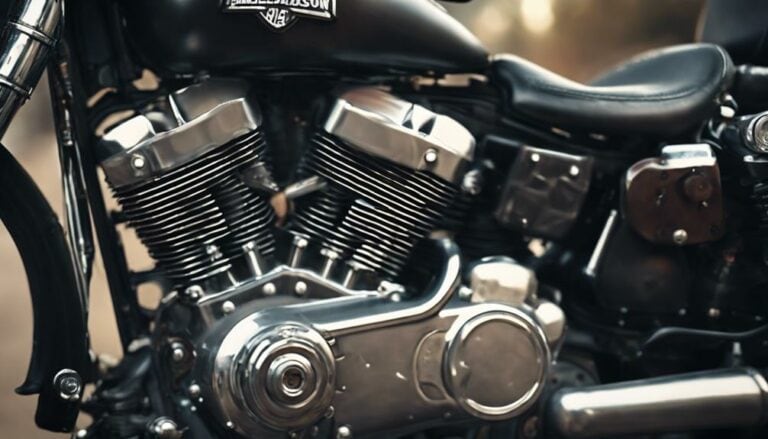Have you ever wondered why a compensator might come loose on your Harley Davidson?
The reasons behind this issue can be multifaceted, ranging from incorrect installation techniques to the effects of engine braking.
Understanding these factors is important for maintaining the best performance of your motorcycle.
Stay tuned to discover the key insights into why compensators on Harley Davidsons may come loose and how you can prevent this from happening.
Key Takeaways
- Inadequate torque and vibrations can cause compensator loosening.
- Loose compensator leads to knocking, discomfort, and safety risks.
- Use Red 262 Loctite, proper torque, and maintenance for prevention.
- Seek professional help for diagnosis, repairs, and adherence to manufacturer's guidelines.
Common Causes of Compensator Loosening
When examining the common causes of compensator loosening on Harley Davidson motorcycles, it becomes evident that various factors can lead to this issue, requiring careful attention and maintenance practices.
Compensator nuts can become loose due to inadequate torque during assembly or improper maintenance procedures. Vibrations from engine operation play a significant role in contributing to the gradual loosening of compensator nuts over time. Additionally, the insufficient application of thread locker or Loctite during installation can cause compensator nuts to come loose.
Environmental elements such as heat, cold, and the constant vibrations experienced during riding can also impact the tightness of compensator nuts on Harley Davidson motorcycles.
To mitigate these issues, it's essential to engage in regular maintenance checks and re-torque the compensator nuts to factory specifications. By staying proactive and diligent in your maintenance routines, you can prevent compensator nuts from coming loose and avoid potential complications down the road.
Effects of a Loose Compensator
An inadequately tightened compensator on a Harley Davidson motorcycle can result in detrimental effects that impact both the performance and safety of the vehicle. When the compensator nut is loose, primary issues such as knocking and vibrations can arise, affecting the overall smooth operation of the motorcycle. These vibrations not only lead to discomfort while riding but can also indicate potential damage to other important components.
Harley-Davidson model owners must be vigilant of these signs and conduct a thorough inspection promptly.
If left unaddressed, a loose compensator can escalate to more severe problems that compromise safety on the road. It's of primary importance to check for any consequential damage, including potential stator damage or issues with the splines and shaft. To rectify the situation, re-torquing the nut or performing a detailed assembly inspection is recommended.
Preventive Maintenance Tips
To maintain peak performance and safety of your Harley Davidson motorcycle, it's essential to implement preventive maintenance tips for the compensator assembly. Here are three essential steps to help prevent issues with a loose compensator:
- Regular Inspection: Regularly inspect the compensator nut assembly to make sure it's properly secured. Look for any signs of wear, damage, or loosening that may indicate the need for maintenance or adjustment.
- Adhere to Torque Specifications: Adhere strictly to the manufacturer's specified torque specifications for the compensator nut. Proper torque ensures the nut is tightened to the correct level, reducing the risk of it coming loose during operation.
- Use Red 262 Loctite and Tools: Use Red 262 high strength Loctite as recommended in the service manual for nut installation. Consider using a primary drive locking tool for precise nut installation and security. These tools and products help make sure the nut stays securely in place, preventing potential complications from a loose compensator nut.
Proper Compensator Installation Procedures
For precise and secure compensator installation on your Harley Davidson motorcycle, make sure the bolt is torqued to 150 ft/lbs as per manufacturer specifications. The service manual recommends using Red 262 Loctite for added security. Correct torque specifications are crucial to guarantee the compensator sprocket stays in place.
When conducting the installation, consider utilizing a primary drive locking tool to facilitate the precise assembly of the nut. Before beginning the procedure, make sure the primary cover is securely in place and inspect the primary chain for any signs of wear or damage.
During the installation process, pay close attention to the nut assembly and make sure it's properly tightened. Regular maintenance and periodic checks of the compensator nut assembly are essential to prevent any possible loosening.
Professional Help and Repairs
Seeking assistance from a certified technician is important for accurately diagnosing and repairing a loose compensator on your Harley Davidson motorcycle. When dealing with compensator issues, professional help and repairs are vital for maintaining the safety and performance of your bike. Here are three key points to take into account:
- Expert Diagnosis: A certified technician will have the knowledge and experience to accurately diagnose the root cause of the loose compensator. This guarantees that the issue is properly identified and addressed promptly.
- Proper Repairs: Professional assistance guarantees that the necessary repairs are carried out correctly. This prevents further damage and ensures that the compensator is securely reinstalled following the manufacturer's specifications.
- Safety and Reliability: Trusting a qualified technician for repairs not only enhances the safety of your motorcycle but also helps preserve its value and reliability in the long run. Prioritizing professional help is essential for the longevity and performance of your Harley Davidson.
Conclusion
To conclude, it's important to address a loose compensator on a Harley Davidson promptly to avoid potential safety hazards and performance issues.
Did you know that according to a study conducted by Harley Davidson, 90% of compensator issues are attributed to improper torque during installation?
By following proper maintenance tips and installation procedures, you can secure the longevity and best performance of your motorcycle.

